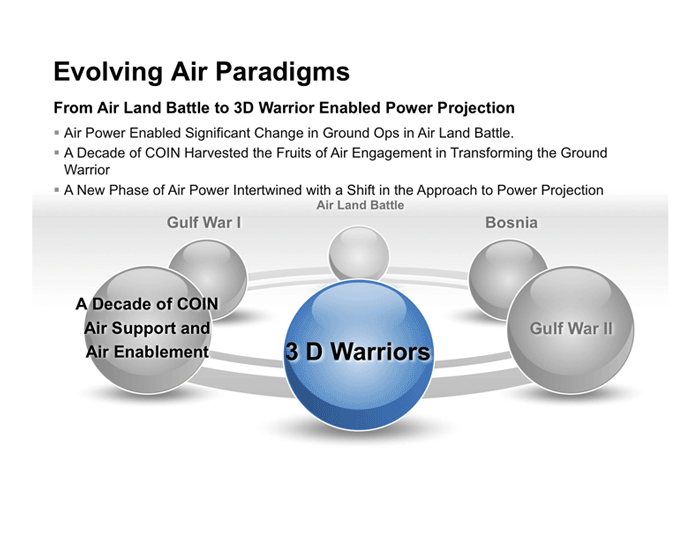The Emergence of the Three Dimensional Warriors
By Robbin Laird
06/16/2011 – As we look forward to the next decade of air power, the question of how best to understand the way forward is rooted in an understanding that past is not prologue. The leveraging of new technologies in preparing for the technologies after next is the most cost-effective as well as operational viable approach.
In broad terms, modern air power has been shaped over the past thirty years by what emerged as air-land battle doctrine. Here the Army was asked to move to a new maneuver concept with air power delivering decisive blows against enemy forces on the battlefield, at the rear, and against moving logistical support elements. This required the acquisition of air superiority, after which air elements engaged with a mobile ground force could seek destruction of enemy forces.

The air-land approach shaped to deal with the Soviet forces facing Europe was executed in the first Gulf War. Here the decisive impact of U.S. and allied forces against the fourth largest army in the world was game changing. Competitors looking at the results noted the need to re-shape their approaches.
Such a re-shaping first started in Bosnia, as the Serbs began to mask and catalogue forces. And to try various techniques to unmask stealth and to use mobile systems to strike air assets. The air campaign was remarkably successful; but only to the point of needing to insert ground forces to shape outcomes. Indeed, the core lesson of air-land battle was the need to combine air power with maneuvering ground forces. This lesson was simply reinforced by the Bosnia experience. With Gulf War II, a new variant of air land battle was implemented, with a significant expansion of the ground maneuvering capability of the USMC and the US Army. In the case of the USMC, they took their airpower with them, in shaping an ability to encircle and destroy Iraqi forces. The USMC began to demonstrate distributed operations enabled by air power, a template that is central to the next age of air power.
The decade of COIN first in Iraq and then in Afghanistan has inverted for many the meaning of airpower. For this generation, air power is largely a support function. The air arm delivers supplies and support to the disbursed ground forces. An air dropping revolution has facilitated an ability for the ground forces to operate without needing to build Walmarts everywhere they go. Aeromedivac has progressed to the point that on average soldiers can be brought back stateside in only three days compare to more than 40 in Vietnam.
Remotely piloted vehicles have been able to create asymmetrical strike options against adversaries who use Pakistani territory. Individual ground units can deploy their own ISR assets to support operations. Indeed, for many RPAs are the future of airpower, but the limitations of these assets are so profound that there is little credibility in making this assumption. But clearly, RPAs are part of the future of air power.
When looking at the decade ahead is the continuation of the COIN model with its assumption of air superiority really a realistic assumption?
A large part of the answer is how innovative U.S. leadership can be. There is a troubling trend to keep buying aircraft the Indians don’t want. They answer in large part is how effectively one leverages fifth generation aircraft and changes strategy, doctrine and tactics to take advantage of what they aircraft bring to the table. The next age could clearly be of what we have called the Three Dimensional Warrior. Here the ability to use air assets to provide for 360-degree situational awareness and flying combat systems becomes a key element for any ground or surface operation. US forces do not want to be in a far fight; moving a COIN force to Three Dimensional Warriors is a core element of ensuring that the US is not seeking equality in warfare.
In many ways, the shift in air power is from a consideration of the air element as operating as the strategic hammer to considering air power as the enabler of multi-spectrum, multi mission operations in the 21st century. The much greater capabilities of individual platforms and of fleets operating with such capabilities in mind enable the ground and surface forces to operate with greater range and effectiveness. A new approach to power projection is possible, whereby the U.S. can link its forces much more effectively, with greater lethality and greater range.


